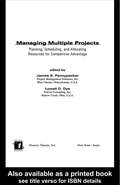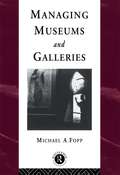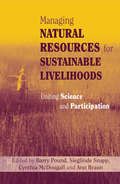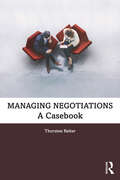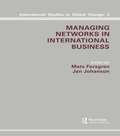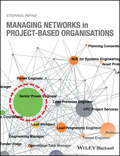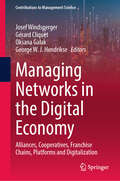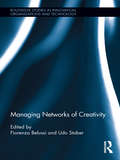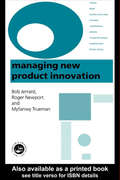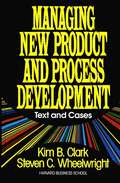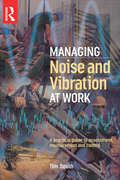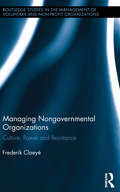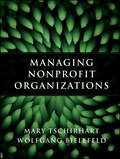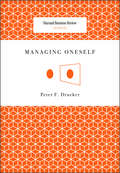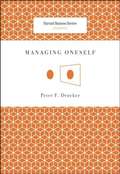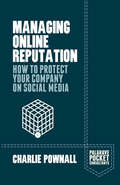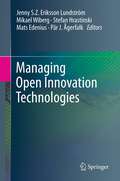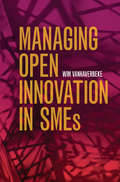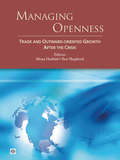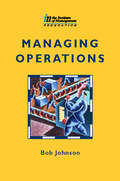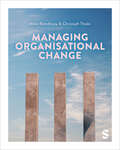- Table View
- List View
Managing Multiple Projects: Planning, Scheduling, and Allocating Resources for Competitive Advantage
by James S. Pennypacker Lowell D. DyeProject leaders, managers, and team members, as well as cost engineers, analysts, and students in project management and planning, can glean ideas and methods for managing multiple projects from this reference. It details time-efficient and cost-effective strategies for evaluating, selecting, prioritizing, planning, and managing multiple projects. The editors present proven methods and practical applications for the development of successful project portfolios and prosperous multi-project environments. Edited by pioneers in the field, with contributions from a panel of experts, the book provides useful models and scheduling frameworks for increased quality and productivity.
Managing Museums and Galleries
by Michael FoppThe current economic climate, coupled with an all embracing desire for museums to be respondent to 'the market' make a proper grounding in management essential. The 'bottom line' is one of the most powerful measures of management performance. Museums and galleries invariably have a neutral bottom line, they are not set up to make a profit and many of them are constrained by governmental accounting rules and charity legislation. Managing these organisations is difficult and this book tackles the issues that make it easier. Managing the Museum examines the highly sophisticated principles and techniques of modern business management from the perspective of museums and galleries and delineates their practical application. This volume surveys the day-to-day issues of time management, delegation and recruitment to the problems of strategic planning and initiating and controlling conflict and change. This study incorporates the needs of both the independent and national sectors and discusses the links between the museum and commerce.
Managing Natural Resources for Sustainable Livelihoods: Uniting Science and Participation
by Cynthia McDougall Barry PoundManagement of local resources has a greater chance of a sustainable outcome when there is partnership between local people and external agencies, and agendas relevant to their aspirations and circumstances. Managing Natural Resources for Sustainable Livelihoods analyses and extends this premise to show unequivocally that the process of research for improving natural resource management must incorporate participatory and user-focused approaches, leading to development based on the needs and knowledge of local resource users. Drawing on extensive and highly relevant case studies, this book presents innovative approaches for establishing and sustaining participation and collective decision-making, good practice for research, and challenges for future developments. It covers a wide range of natural resources - including forests and soils, and water and management units, such as watersheds and common property areas - and provides practical lessons from analysis and meta-analysis of cases from Asia, Africa and Latin America. It offers insights on how to make research participatory while maintaining rigour and high-quality biological science, different forms of participation, and ways to scale up and extend participatory approaches and successful initiatives. This book will be invaluable for those professionally involved in natural resource management for sustainable development and an essential resource for teachers and students of both the biophysical and social science aspects of natural resource management.
Managing Natural and Cultural Heritage for a Durable Tourism
by Anna Trono Valentina Castronuovo Petros KosmasThis contributed volume offers a wealth of cases that explore the factors and conditions required for heritage tourism to be economically and socially beneficial to local communities without impairing the natural environment, cultural heritage preservation, or sustainability for future generations. The studies presented here comprise an examination of measures which have been and can be implemented to ensure sustainable use of natural and cultural systems, leading to a new concept of tourism that incorporates science and community practices together to create a favorable environment where tourists and locals can experience meaningful interactions and experiences. The book focuses on the role of stakeholders in the development of a new policy regarding the sustainable management of cultural tourism and the possibility of their involvement in the processes governing policy-making. Emphasis is placed on the role and commitment of local and international authorities, including UNESCO, in preserving the world's endangered cultural and natural heritage, as well as the responsibilities of Member States and public and private actors with respect to future conservation challenges.
Managing Negotiations: A Casebook
by Thorsten ReiterManaging Negotiations is a collection of seven global, real-life case studies on prominent negotiations in the realm of international business and politics. The book combines the rigorously researched frameworks of academia with the real-world challenges of negotiations. The cases combine scientific negotiation management practices as well as theories with real-world examples that demonstrate how to conduct successful negotiations and which prominent pitfalls to avoid. The topics discussed reach from mergers & acquisitions, collective bargaining, international diplomatic treaties to international free trade agreements. Each case study starts with an overview comprising three key objectives and ends with the key learnings as well as reflective questions for class discussion. This casebook can be used as recommended reading on Negotiation and Strategic Management courses at postgraduate, MBA and Executive Education level and serves as a guide for practitioners responsible for contract management, negotiation and procurement.
Managing Negotiators: How Do You Steer Them Toward Deals Worth Doing?
by Danny Ertel Mark GordonNegotiation may seem like the last unmanageable frontier in business yet even star negotiators need guidance and management. This chapter includes coaching questions and competency guides to help in your management of negotiators.
Managing Networks in International Business
by M. Forsgren J. JohansonThe book introduces a unique and innovative perspective for the study of international business networking. In contrast to the standard construction of models for optimal strategic decision-making, the essays in this book emphasise interpretation, learning by doing, trust and co-operation in the international business community. The editors focus upon business relationships within and between firms as well as the importance of middle management in the international arena.
Managing Networks in Project-Based Organisations
by Stephen PrykeThe first book demonstrating how to apply the principles of social network analysis to managing complex projects This groundbreaking book gets project managers and students up to speed on state-of-the-art applications of social network analysis (SNA) for observing, analysing, and managing complex projects. Written by an expert at the leading edge of the SNA project management movement, it clearly demonstrates how the principles of social network analysis can be used to provide a smarter, more efficient, holistic approach to managing complex projects. Project managers, especially those tasked with managing large, complex construction and engineering projects, traditionally have relied upon analysis and decision-making based upon hierarchical structures and vaguely defined project systems, much of which is borrowed from historic scientific management approaches. However, it has become apparent that a more sophisticated methodology is required for observing project systems and managing relationships with today’s more knowledgeable and demanding clients. Social network analysis (SNA) provides just such an approach. Unfortunately, existing books on social network analysis are written primarily for sociologists and mathematicians, with little or no regard for the needs of project managers — until now. The first and only book of its kind, Managing Networks in Project-Based Organisations: Offers a framework and a fully-developed approach to applying SNA theory and methodologies to large, complex projects Describes highly effective strategies and techniques for managing the iterative and transient relationships between network-defining actor roles involved in the delivery of complex projects Uses numerous real-world examples and case studies of successful applications of SNA to large-scale construction and engineering projects around the world Draws on its author’s decades of experience managing complex projects for demanding clients, as well as his extensive academic research in Project Management Managing Networks in Project-Based Organisations is an important working resource for project management professionals and consultants, especially those serving the construction and engineering industries. It is also an excellent text/reference for postgraduate students of project management and supply chain management, as well as academic researchers of project management.
Managing Networks in the Digital Economy: Alliances, Cooperatives, Franchise Chains, Platforms and Digitalization (Contributions to Management Science)
by Gérard Cliquet Josef Windsperger George W. J. Hendrikse Oksana GalakThis book presents recent developments in the theory and management of networks (such as alliances, cooperatives, franchise chains) and platforms. In addition, it explores the impact of digitalization on networks and presents empirical studies on digital platform businesses. The book will be of major interest to scholars and students of economics of organization, business and management, governance of networks and digital platforms, and practicing managers.
Managing Networks of Creativity (Routledge Studies in Innovation, Organizations and Technology)
by Udo Staber Fiorenza BelussiThe aim of the Managing Networks of Creativity is to improve our understanding of creativity and the management of creativity, as discussed in the fields of management (including strategic management, organization science, organizational behaviour, and entrepreneurship), economics, sociology, regional studies, and political science. While research on creativity has made several important contributions to the theoretical literature, little attention has been paid to the development and testing of formal theoretical models, especially in those cases where creativity is the result not so much of individual behaviour than the outcome of collective efforts, connecting individuals in organizations, social networks, projects, geographic clusters, and so forth. The proposed volume includes studies, both conceptual and empirical, which, as a whole, "deconstruct" the concept of creativity and the management of creativity by identifying specific situations, contexts, firms, clusters, and districts in which creative processes evolve. The reader is provided with in-depth discussions of theoretical issues and a range of descriptive cases and survey data that the authors use to explore or test concepts and models. Overall, the volume aims to integrate current debates concerning the role of creativity (and innovation) in economic and social development.
Managing New Product Innovation
by Bob Jerrard Myfanwy Trueman Roger NewportNew product design and development is often the result of personal vision. Harnessing this often requires a special receptiveness and enthusiasm at all levels of an organization, which serves to unlock potential and can turn the entire organizational pyramid upside-down. It is particularly important to understand and develop those aspects of design which can be constructively employed by designers in a strategic alliance with management and research.; The papers in this volume result from the conference of the Design Society held at the University of Central England in September 1998. They show how design-led product development has worked in a range of industries, from engineering through to design and management consultancy.
Managing New Product and Process Development
by Steven C. WheelwrightArgues that a company's capability to conceive and design quality prototypes and bring a variety of products to market more quickly than its competitors is increasingly the focal point of competition. The authors present principles for developing speed and efficiency.
Managing Noise and Vibration at Work: Assessment, Measurement And Control
by Tim SouthNew EU Physical Agents Directives on Noise and Vibration will be incorporated into UK law by February 2006. Explicit action levels for vibration will be introduced, while the action levels for noise will be drastically cut. In order to comply with these Directives, companies need to assess noise and vibration levels and provide necessary protection for their employees. They are also required to monitor and if necessary reduce noise and vibration risks.Managing Noise and Vibration at Work introduces noise and both hand-arm and whole-body vibration by explaining what they are and how they can affect the body, drawing out the similarities and differences between the hazards. It provides clear explanations of the requirements of the EU Directives and explains how to fulfill them. Practical information on measurement, making noise and vibration assessments, and approaches to controlling risk help the reader to understand the issues of noise and vibration exposure in the workplace. The text is supported by information and diagrams of measuring equipment, advice on how to plan a survey, worked examples of necessary calculations, and charts and diagrams that can be used in place of the calculations. Suitable hearing and vibration protection is detailed. Case studies help to set the subject in context and highlight common errors and pitfalls.The book fully covers the syllabuses of the Institute of Acoustics’ certificate courses in Workplace Noise Assessment and Management of Occupational Exposure to Hand-arm Vibration. It will also be of use to those studying for the Diploma in Acoustics and Noise Control. For those studying for the NEBOSH Diploma in Health and Safety, this book satisfies modules 1E and 2E. As the Institute of Acoustics syllabuses are based on the Health and Safety Executive's guidelines, the book will also be a useful up-to-date reference for: risk managers; Health and Safety advisors and managers; occupational hygienists; environmental health officers; and HSE inspectors, especially in the Construction, Manufacturing, Agriculture and Forestry sectors.Tim South is a Senior Lecturer in Acoustics at the School of Health and Human Sciences at Leeds Metropolitan University, and a member of the Institute of Acoustics’ Education Committee. He teaches the Institute of Acoustics courses for the Certificate of Competence in Workplace Noise Assessment, the Certificate in the Management of Occupational Exposure to Hand-arm Vibration, and also the Institute’s Diploma in Acoustics and Noise Control. He has extensive consultancy experience in workplace noise assessments, hand-arm vibration and whole-body vibration exposure assessments.
Managing Nongovernmental Organizations: Culture, Power and Resistance (Routledge Studies in the Management of Voluntary and Non-Profit Organizations)
by Frederik ClaeyéThe idea that international development aid needs to be better managed and coordinated gained currency in the early 1990s. The increasing emphasis on management has resulted in the present vogue of ‘managing for development results’ as one of the central tenets in the discourse on international aid. But how appropriate are these ideas, tools, and techniques for non-governmental development organizations (NGOs), and how much does geographic context matter? Examining the current debate on aid effectiveness and the role of NGOs in contributing to it, this book highlights the critical importance of understanding how the global and the local interact to increase aid efficacy and develop more culturally astute ways of managing NGOs. With a focus on NGOs active in sub-Saharan Africa as case studies, author Frederik Claeyé demonstrates that NGOs are not mere passive recipients of management knowledge and practices emanating from the global governance structure of international aid, but actively engage with these ideas and practices to translate and rework them through a local cultural lens. This process results in the emergence of unique hybrid management systems that combine the pressure to become more business-like with the mission to satisfy the demands of the communities they serve.
Managing Nonprofit Organizations: Managing Stakeholder Problems In Nonprofit Arts Organizations (Indiana University Center On Philanthropy Series In Governance Ser.)
by Mary Tschirhart Wolfgang BielefeldThis essential resource offers an overall understanding of nonprofits based on both the academic literature and practitioner experience. It shows how to lead, manage, govern, and structure effective and ethical nonprofit organizations. Managing Nonprofit Organizations reveals what it takes to be entrepreneurial and collaborative, formulate successful strategies, assess performance, manage change, acquire resources, be a responsible financial steward, and design and implement solid marketing and communication plans. "Managing Nonprofit Organizations is the only introductory text on this subject that manages to do three critical things equally well: It's comprehensive, covering all the key topics leaders of NPOs need to know about; it's practical, providing lots of examples, case incidents, and experiential exercises that connect the content to the real world; and, best of all (and most unique compared to others), it's research-based, drawing on the latest and best empirical studies that look into what works and doesn't work in the world of nonprofit management. " --Vic Murray, professor, School of Public Administration, University of Victoria "This book is a rarity--a text that can be used both as the focus for academic study and as a source of stimulating ideas for those practitioners who want to explore theories about management and how they can be applied so they can do a better job. Tschirhart and Bielefeld have explained all aspects of nonprofit management and leadership in a way that will stimulate as well as inform. " --Richard Brewster, executive director, National Center on Nonprofit Enterprise, Virginia Tech University "Managing Nonprofit Organizations presents a comprehensive treatment of this important topic. The book satisfies the competencies and curriculum guidelines developed by NASPAA and by NACC and would be ideal for instruction. The book maintains its commitment to informing management and leadership throughout the nonprofit sector. " --Jeffrey L. Brudney, Albert A. Levin Chair of Urban Studies and Public Service, Cleveland State University "This is an important book, written by two of the leading scholars in the nonprofit studies field. Nonprofit managers, board members, funders, educators, and others will find Managing Nonprofit Organizations extremely valuable. " --Michael O'Neill, professor of nonprofit management, University of San Francisco "Here's the book that my students have been asking for--just the right mix of theory presentation, research findings, and practical suggestions to serve the thoughtful nonprofit management practitioner. It will inform, instruct, and ultimately, inspire. " --Rikki Abzug, professor of management, Anisfield School of Business, Ramapo College
Managing Oil Wealth: The Case of Azerbaijan
by Eric Le Borgne Stephan Danninger John Wakeman-Linn Chonira Aturupane Koba Gvenetadze Niko HobdariOil and gas production in Azerbaijan are projected to increase sharply in 2005 and 2006, respectively, reaching peaks of 1. 3 million barrels per day in 2009 and 20 billion cubic meters per year in 2010. Although expected revenues over the next 20 years will be substantial, they are projected to return to 2004 levels by 2024. Managing this temporary windfall in a way that allows for economic diversification and increased living standards is the subject of this book, which provides extensive guidance based largely on lessons drawn from the experiences-mostly negative-of other countries.
Managing Oneself
by Peter F. DruckerWe live in an age of unprecedented opportunity: with ambition, drive, and talent, you can rise to the top of your chosen profession regardless of where you started out. But with opportunity comes responsibility. Companies today aren't managing their knowledge workers' careers. Instead, you must be your own chief executive officer. That means it's up to you to carve out your place in the world and know when to change course. And it's up to you to keep yourself engaged and productive during acareer that may span some 50 years. In Managing Oneself, Peter Drucker explains how to do it. The keys: Cultivate a deep understanding of yourself by identifying your most valuable strengths and most dangerous weaknesses. Articulate how you learn and work with others and what your most deeply held values are. Describe the type of work environment where you can make the greatest contribution. Only when you operate with a combination of your strengths and self-knowledge can you achieve true and lasting excellence. Managing Oneself identifies the probing questions you need to ask to gain the insights essential for taking charge of your career.
Managing Online Reputation: How to Protect Your Company on Social Media (Palgrave Pocket Consultants)
by Charlie PownallManaging Online Reputation is a comprehensive look at online reputation management. Drawing on recent examples of organizations managing their online reputations effectively and ineffectively, it provides a practical and visual tool-kit of processes and techniques to help limit and respond effectively to negative situations on social media.
Managing Open Innovation Technologies
by Pär J. Ågerfalk Mikael Wiberg Jenny S. Eriksson Lundström Mats Edenius Stefan HrastinskiOpen innovation increases the profit of companies and organizations via the input and the adoption of new ideas that are transformed into new processes, products, and services. Yet, how do we ensure that adopters of such innovations focus on relevant problems and use appropriate methods? How should we manage open innovation technologies? How can we exploit distributed knowledge and inventions? And how can we promote them successfully on the market? With valuable lessons to be learned from academic research and industrial experiences of e.g. Intel, Nokia, Philips Healthcare, small municipalities, e-learning platforms and user communities, this book focuses on some of the key dimensions of open innovation and open innovation technologies. It is divided into three themes: theme 1 deals with open innovation as it is in use today, including theoretical underpinnings and lessons from related research fields. Theme 2 analyzes the use of open innovation in organizations today in order to extract best practices. Theme 3 presents forward-looking theoretical research as well as practical future uses of open innovation. Each chapter addresses the particular topics by presenting experiences and results gained in real life projects and/or by empirical research, and clearly states its purpose and how readers are supposed to benefit from it. Overall, the objectives of this book are to advance and disseminate research on systematic open innovation, and to make its results available to practitioners. Thus, the intended target audience includes the international academic community, industrial enterprises, and public authorities.
Managing Open Innovation in SMEs
by Wim VanhaverbekeThe concept of open innovation (OI) has become a very popular topic during the last decade, with an increasing number of small- and medium-sized enterprises (SMEs) embracing OI practices to gain competitive advantage. With the majority of publications focusing on large firms, open innovation in SMEs has received scant attention from both scholars and practitioners. This book seeks to correct this imbalance by providing an in-depth study for both business managers and graduate-level students. Using rich, in-depth case studies from successful companies, it examines different approaches to managing OI in order to develop practical guidelines for implementation. It also highlights important differences between OI strategies in SMEs and large companies. Its findings will be of use to those studying or working in innovation management, open innovation, small business management and entrepreneurship.
Managing Openness
by Mona Haddad Ben ShepherdThe global financial crisis triggered a broad reassessment of economic integration policies in developed and developing countries worldwide. The crisis-induced collapse in trade was the sharpest ever since World War II, affecting all countries and all product categories. A huge shock to the trading system, combined with severe macroeconomic instability, makes it natural for policymakers to call into question the basic underlying assumptions of trade liberalization and openness. In particular, outward-oriented or export-led growth strategies are being reassessed as openness is increasingly associated with greater volatility. However, it is crucial not to lose sight of the dynamic benefits that openness can offer. Examples include technology transfer, increased competitive pressure that reduces markups and improves efficiency, and economies of scale. The real question is how to manage outward-oriented strategies so as to maximize the benefits of openness while minimizing risks. This book aims to contribute to this important and ongoing policy debate, bringing together recent empirical work on the trade collapse, its causes and consequences, and the broader trade policy agenda in the post-crisis environment. It addresses critical policy issues revolving around the topic of outward-oriented growth strategy, including policy instruments that help manage risks associated with outward-orientation, lessons learned from the crisis for particular countries and regions, and how emerging trade policy issues such as climate change, commodities, global production networking, and migration affect the prospects for recovery and outward-oriented growth.
Managing Operations
by Bob Johnson Alan HartManaging Operations is a concise guide to the fundamentals of operations management. Using examples and case studies from public, private and voluntary sector organizations, this book will enable managers to develop their competency to an excellent standard in an industrial or commercial setting. As well as being very practically based, Managing Operations also provides the theory behind operations management.The book is based on the Management Charter Initiative's Occupational Standards for Management NVQs and SVQs at level 4. It is particularly suitable for managers on the Certificate in Management, or Part 1 of the Diploma, especially those accredited by the IM and Edexcel.Managing Operations is part of the highly successful series of textbooks for managers which cover the knowledge and understanding required as part of any competency-based management programme. The books cover the three main levels of management: supervisory/first-line management (NVQ level 3), middle management (Certificate/NVQ level 4) and senior management (Diploma/NVQ level 5). Also included are titles which cover management issues in particular sectors, such as schools or the public sector, in more depth. You will find a full listing of other titles available at the front of this book.Bob Johnson is a freelance management consultant and trainer with extensive experience of the retail, service, government and voluntary sectors. He has managed operations in the sales, marketing, purchasing, training and consultancy functions.
Managing Organisational Change
by Allan Ramdhony Christoph ThieleDiscover a fresh perspective on managing organisational change in this accessible textbook which links theory to practice and brings complex concepts to life. Structured around the three pillars of successful change management, the book examines change in the context of the global economy and looks at a range of international examples. Key features include: Case studies which explore the practical implications of change issues through companies such as the Alibaba Group, NHS England, GSK, Tata Motors, Nike, Hewlett-Packard and Indonesia’s Krakatau Steel. Practical and reflective exercises to encourage experimentation with tools and techniques, and to deepen understanding.
Managing Organisational Change
by Allan Ramdhony Christoph ThieleDiscover a fresh perspective on managing organisational change in this accessible textbook which links theory to practice and brings complex concepts to life. Structured around the three pillars of successful change management, the book examines change in the context of the global economy and looks at a range of international examples. Key features include: Case studies which explore the practical implications of change issues through companies such as the Alibaba Group, NHS England, GSK, Tata Motors, Nike, Hewlett-Packard and Indonesia’s Krakatau Steel. Practical and reflective exercises to encourage experimentation with tools and techniques, and to deepen understanding.
